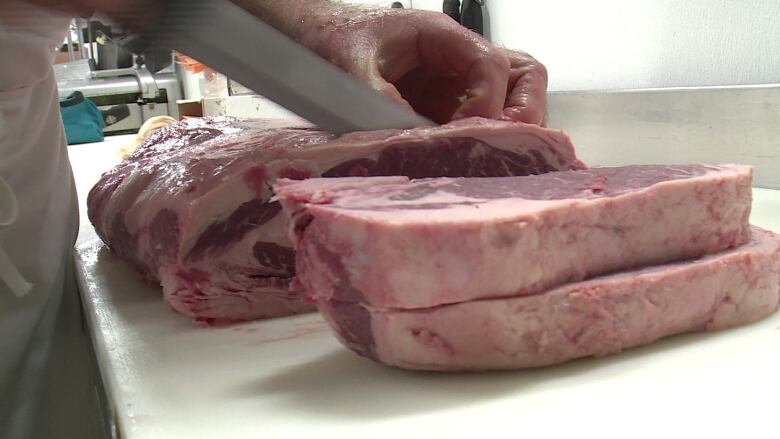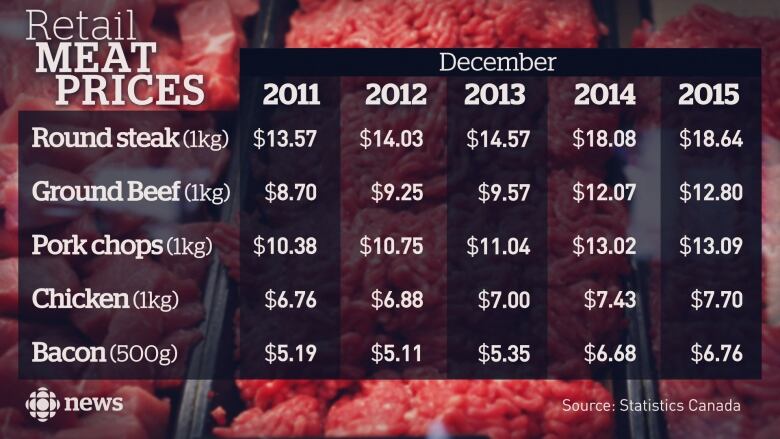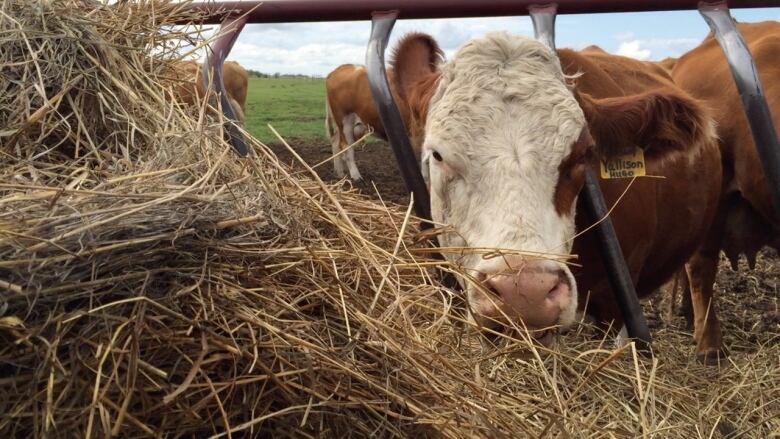Beef prices begin sudden fall from record highs
Grocery store prices start to drop for steaks, roasts and ground beef

The boom market for beef is fadingin Canada after record prices last year, but people will have to wait forcosts to tumblein grocery stores.
The cattle industry has experienced a sudden drop in prices, forcing ranchers to adjust their expectations for the year.
"We had anincredible run. We doubled our prices in three years for calves, for example," saidBrianPerillat, a senior analyst withCanFax, a cattle market research firm."In the last few months, we've seen prices drop 15 to 20 per cent from the high."
- Pulse crop prices jump in Canada, even as supply grows
- Canadian beef exports to South Korea to resume
Even with the marketcorrection, prices are still at historically high levels. Experts say the price spike was too extremea reaction as beef supplies tightened.
"It's a commodity market. We see big booms and busts with oil and we went through one with cattle," saidPerillat.
Price lag in stores
Steaks, roasts and other cuts of beef are still fetching a premium price in the meat department of grocery stores, although that should change. Usually it takes three to six months before changes to cattle prices affect retail prices.
The skyrocketing prices proved to be a double-edged sword for the industry. Whileprofits increased, some grocery store customers reacted to the sticker shock.
If we want to sell more beef, we need to make it easy for the consumer.Gary Haley,Vantage Foods

Eating habits
Despite recent financial success, thebeef industry faces several challenges as it losesmarket share in the country, while trying to adapt to a change ineating habits byCanadians.
The hefty prices for beef, and meat in general, havemore and more people looking to buy other sources of protein such as eggs, tunaand beans. At the same time,consumers increasingly want food that is healthy, tasty and quick to make.
"The way consumers are eating meat is changing. Centre of the plate usage is declining. Meat as an ingredient is increasing," said Gary Haley with Vantage Foods, a Calgary-based food processor.
Haley spoke Thursday at theAlberta Beef Industry Conference in Red Deer, Alta.
In particular, the younger generation is a puzzle the industry is trying to solve.
"These pesky millennials are a bit of a challenge, because the only meat that really resonates with them in consumer research is chicken," Haley told the crowd of 300 people. "They can't cook, they don't want to cook and we need to figure out how we can supply this young group."
The desire for versatile, low-cost and quickly prepared meals explains whyground beef outsells all other cuts of beef.
Per capita beef consumption dropped in Canada by 12 per cent from 2003 to2012, according to Statistics Canada.
The price of meat is the biggest deciding factor for people in grocery stores. The recent "phenomenal" spike in beef prices has turned away some consumers.
"We work in a commodity market and it's cyclical. In the last couple of years, prices have been higher, but that will ultimately change and normalize in the future," said Haley in an interview.
Many questions
Other challenges for the beef industry include increased demands for transparency andsustainability. Questions about animal welfare and processing are becoming more prevalent and influencing how some people buy meat.

"If we want to sell more beef, we need to make it easy for the consumer. We need to make it interesting. We need to enhance flavour profiles. We need to demonstrate how to cook it and those types of things."
The sector also needs to keep pace with the trendof smaller packages of meat and more value-added products.
"I don't think we can stay where we are, because the times are a changing," he said.
In Canada, beef production keeps falling, although experts suggest that could change in 2016.
While theindustry has seen the number of cattle decrease over the last decade, the size of cattle keeps climbing. In 1975, the average carcass weight was just above 270 kilograms, while in 2014 the weight was over 400 kilograms, according toCanFax.












_(720p).jpg)


 OFFICIAL HD MUSIC VIDEO.jpg)
.jpg)



























































































